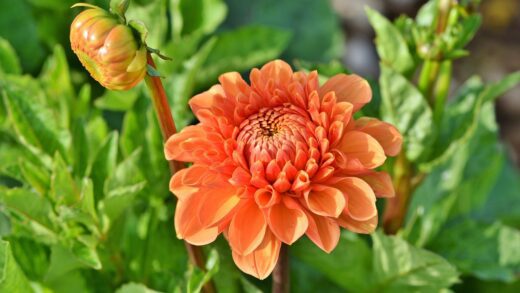The artichoke, a majestic plant of Mediterranean origin, is becoming increasingly popular in home gardens, but the biggest challenge in its cultivation is surviving the winter frosts. As it is accustomed to mild winters in its native habitat, the harsher conditions of a continental climate pose a serious threat, making proper overwintering essential for establishing a multi-year, abundantly yielding stand. The correct overwintering technique not only ensures the plant’s survival but also lays the foundation for vigorous growth and plentiful flower bud formation the following year. Without this careful attention, the artichoke would behave merely as an annual in most gardens, significantly reducing the economic and enjoyable value of its cultivation.
The frost sensitivity of the artichoke is precisely determinable, which is crucial for planning an overwintering strategy. The above-ground parts of the plant die back after the first serious frosts of minus 4-5 degrees Celsius, which is part of a natural process. The real danger lies in prolonged soil temperatures below minus 10 degrees Celsius, which pose a threat to the root crown, the perennial part of the plant, and can cause irreversible damage, leading to the plant’s demise. While a snow cover can provide natural insulation, one should never fully rely on it for protection due to unpredictable winter weather. The first signs of cold damage are the browning and wilting of the leaves, and in more severe cases, the softening and rotting of the central part of the plant, its heart.
The primary goal of overwintering is, therefore, to protect the root crown from critical temperature values, thereby ensuring the plant’s revival in spring. A successfully overwintered artichoke plant will start growing much earlier and with more energy in the spring than a seedling planted in spring, which has a direct impact on the yield. Well-overwintered plants develop earlier and produce more, larger, and better-quality buds, as the nutrients stored in the root system can be immediately directed towards shoot formation. This process is closely linked to the plant’s perennial life cycle, which can only be maintained in many climates through conscious human intervention.
It is important to differentiate between overwintering young, first-year plants and established, older plants. The root systems of young specimens are still less developed and more vulnerable, thus requiring more thorough protection against winter hardships. In contrast, older, multi-year plants have a more extensive and deeper-reaching root system, making them slightly more resistant to the freezing of the upper soil layer. Nevertheless, their protection must also be ensured, though the extent of the covering may be somewhat more moderate. The chances of success can also be increased by choosing more cold-tolerant varieties, although the basic overwintering procedures cannot be omitted for any variety.
Preparing for winter in the open field
The most critical point in preparing field-grown artichokes for winter is proper timing. The work should not be started too early, as the plant needs the cool but still frost-free weather of late autumn to naturally harden off and “toughen up” for the cold season. The appearance of the first light ground frosts signals that it is time to act, which is when the foliage should be cut back and preparations for covering should begin. If the plant is covered too early, the still-warm soil and the moisture accumulating under the cover can promote fungal diseases, such as crown rot. The goal is to encourage the plant to enter dormancy, not to artificially maintain its vegetation.
More articles on this topic
Cutting back the foliage is a fundamental step in the overwintering process and must be done carefully. All leaves and stems should be cut back to a height of about 20-30 centimeters above the ground using sharp pruning shears or a knife. There are several reasons for this: firstly, removing the drying, decaying foliage reduces the chance of pathogens and pests overwintering around the crown. Secondly, the trimmed, compact plant is much easier and more effective to cover with insulating material later on. When cutting back, be careful not to damage the central part of the plant, the heart bud, as this is where new growth will emerge in the spring.
After cutting back, the most important line of defense follows: mulching, which is intended to provide thermal insulation for the root crown. For this purpose, a thick layer of organic covering material should be piled around the base of the plant to effectively protect the soil from deep freezing. Dry fallen leaves, straw, wood shavings, mature compost, or even pine bark are excellent for this purpose; the key is that the material used should be loose in structure and completely dry. The ideal thickness of the mulch layer is at least 25-30 centimeters, which should be piled up in a cone shape around the crown, completely covering the remaining stem stubs. Wet covering material can initiate rot, so during wetter periods, it is advisable to protect the organic mulch with a waterproof but breathable layer, such as a piece of plastic sheeting or pine branches.
In regions with particularly harsh winters or to further enhance protection, additional methods can be employed. An inverted wooden crate, a large clay pot (with its drainage hole left open for ventilation), or even a tent made of special horticultural fleece can be placed over the mulch pile. These structures create an additional air layer between the mulch and the external environment, which further improves the efficiency of the insulation. Another proven method is to simply mound soil up around the plant, similar to overwintering roses, and then spread the thick layer of organic mulch over this soil mound, thus combining the insulating properties of different materials for maximum protection.
Overwintering potted artichokes
In colder climate regions where overwintering in the open field is too risky, growing artichokes in containers is an excellent alternative. The greatest advantage of plants kept in tubs or large pots is their mobility, which allows them to be easily moved to a protected, frost-free location when the frosts set in. This method provides almost one hundred percent security against winter frost damage, but certain disadvantages must also be considered. The root system of potted plants is more exposed to temperature fluctuations and can freeze more quickly than those in the ground, so leaving them outdoors is not recommended even during mild frosts. Additionally, they require very large containers, at least 40-50 liters, for proper development, which represents a significant weight.
More articles on this topic
The key to successful overwintering is choosing the right location, which should be cool but guaranteed to be frost-free, and ideally, should receive some diffused light. The perfect overwintering spot is an unheated garage, a cellar, a cold conservatory, a glazed veranda, or a frost-free greenhouse. It is important that the temperature remains stable between 2 and 8 degrees Celsius during the winter months. A warm, heated indoor environment is expressly unsuitable for overwintering, as it disrupts the plant’s natural dormant period, stimulating premature, weak shoot growth, which exhausts the root system and leads to the plant’s weakening in the spring.
Preparing the potted plant for its winter dormancy is very similar to its field-grown counterparts, but differs in a few points. After the first light frosts, when the foliage has been slightly nipped, cut back the leaves and stems to about 20 centimeters above the soil. Following this, the most important task is to drastically reduce watering. During overwintering, the plant only needs enough water to prevent the root ball from drying out completely. It is usually sufficient to water with a small amount of water every 3-4 weeks, allowing the soil to almost completely dry out between waterings. Overwatering, combined with the cool environment, will almost certainly lead to root rot.
Even during the dormant period, the plant should not be completely neglected; regular but non-intrusive checks are essential. Take a look at the pot every two weeks or so to make sure everything is in order. Monitor the moisture content of the root ball and, if necessary, replenish the water as described above. Also, check for the appearance of pests, such as spider mites or aphids, which can remain active in the overwintering location. In late winter, from the end of February, as the days get longer, you can gradually start acclimatizing the plant to a brighter location and increase the amount of watering, preparing it for its spring awakening.
Spring tasks after successful overwintering
The timing of removing the winter protection is at least as critical as its application in the autumn. The most common mistake one can make is uncovering the plant too early, which exposes the newly awakening, tender shoots to the danger of late spring frosts and can ruin the entire year’s work. The right time comes when the night temperatures consistently stay above freezing and the danger of hard frosts has passed, which in many temperate climates is typically mid-to-late April. Always monitor the weather forecast and be patient; it is better to wait an extra week to uncover than to risk the plant’s health.
The removal of the cover should not be done in a single motion, but gradually, over several days or even a week or two. This process helps the plant to slowly acclimatize to the changed conditions: stronger sunlight, wind, and greater daily temperature fluctuations. First, remove the top, waterproof layer of the cover (if one was used), then, day by day, break up the organic mulch pile, leaving a larger area around the base of the plant exposed. This will prevent the sensitive shoots, suddenly exposed to light and temperature changes, from getting “burned” or shocked. During the uncovering process, also thoroughly inspect the condition of the crown, looking for any signs of rot or frost damage.
Once the plant is completely free of its winter cover and the weather has turned favorable, it is time for the first spring feeding. Overwintering and the start of spring growth require a great deal of energy from the plant, so it will be grateful for a dose of balanced, nitrogen-rich organic manure or mature compost, carefully worked into the soil around the base. This nutrient boost provides the initial impetus for the intensive development of new shoots and leaves. At the same time as fertilizing, begin regular watering according to the soil’s moisture content as the plant starts to grow actively.
It may happen that despite the most careful overwintering, you find some frost damage or rot on the plant, but you don’t have to give up on it immediately. Carefully remove any soft, brown, rotten parts with a sharp, clean knife down to the healthy, hard tissue to prevent the spread of infection. In many cases, if the major part of the root crown has remained intact, the plant is able to regenerate and produce new shoots from the root neck or from the soil. In such cases, proper watering and nutrient supply are particularly important, as well as a large dose of patience, as the plant needs time to recover from the damage and regain its strength.


















